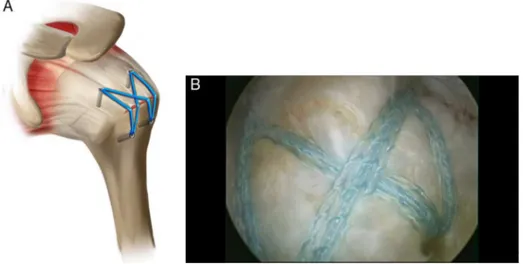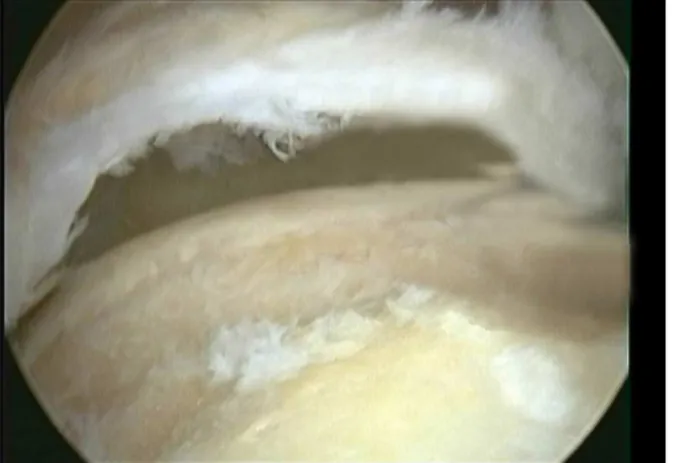SOCIEDADE BRASILEIRA DE ORTOPEDIA E TRAUMATOLOGIA
w w w . r b o . o r g . b r
Original
article
Evaluation
of
the
functional
results
after
rotator
cuff
arthroscopic
repair
with
the
suture
bridge
technique
夽
Alberto
Naoki
Miyazaki
∗,
Pedro
Doneux
Santos,
Guilherme
do
Val
Sella,
Caio
Santos
Checchia,
Thiago
Roncoletta
Salata,
Sergio
Luiz
Checchia
FaculdadedeCiênciasMédicasdaSantaCasadeSãoPaulo,DepartamentodeOrtopediaeTraumatologia,SãoPaulo,SP,Brazil
a
r
t
i
c
l
e
i
n
f
o
Articlehistory:
Received26February2016
Accepted2May2016
Availableonline2March2017
Keywords:
Rotatorcuff
Arthroscopy Sutures
a
b
s
t
r
a
c
t
Objective:Toevaluatetheresultsofarthroscopictreatmentoflargeandextensiverotatorcuff
injuries(RCI)thatinvolvedthesupraandinfraspinatusmusclesusingthesuturebridge(SB)
technique.
Methods:BetweenJuly2010andNovember2014,37patientswithRCIwhoweretreated
withSBtechniquewereevaluated.Thestudyincludedallpatientswithaminimum
follow-upof12monthswhounderwentprimarysurgeryoftheshoulder.Twenty-fourpatients
weremaleand13 werefemale.Themeanagewas60years(45–75).Thedominantside
wasaffectedin32cases.Themostcommoncauseofinjurywastrauma(18cases).The
meanpreoperativemotionwas123◦,58◦,T11.Throughmagneticresonanceimaging,36
fattydegenerationswereclassifiedaccordingtoGoutallier.Patientsunderwentrotatorcuff
repairwithSBtechnique,whichconsistsofusingamedialrowanchorwithtwoCorkscrew®
fibertape® orfiberwire® atthearticularmargin,associatedwithlateralfixationwithout
stitchusingPushLocks®orSwiveLocks®.
Results:Themeanagewas60yearsandmeanfattydegenerationwas2.6.Themeanrange
ofmotion(followingtheAAOS)inthepostoperativeevaluationwas148◦offorward
eleva-tion,55◦inlateralrotationandmedialrotationinT9.UsingthecriteriaoftheUniversity
ofCaliforniaatLosAngeles(UCLA),35(94%)patientshadexcellentandgoodresults;one
(2.7%),fair;andone(2.7%),poor.
Conclusion:ArthroscopicrepairofalargeandextensiveRCIusingSBtechniquehadgood
andexcellentresultsin94%ofthepatients.
©2017PublishedbyElsevierEditoraLtda.onbehalfofSociedadeBrasileiradeOrtopedia
eTraumatologia.ThisisanopenaccessarticleundertheCCBY-NC-NDlicense(http://
creativecommons.org/licenses/by-nc-nd/4.0/).
夽
StudyconductedattheFaculdadedeCiênciasMédicasdaSantaCasadeSãoPaulo,DepartamentodeOrtopediaeTraumatologia,
GrupodeCirurgiadeOmbroeCotovelo,SãoPaulo,SP,Brazil.
∗ Correspondingauthor.
E-mail:amiyazaki@uol.com.br(C.S.Checchia).
http://dx.doi.org/10.1016/j.rboe.2016.05.008
2255-4971/©2017PublishedbyElsevierEditoraLtda.onbehalfofSociedadeBrasileiradeOrtopediaeTraumatologia.Thisisanopen
Avaliac¸ão
dos
resultados
funcionais
após
reparo
artroscópico
do
manguito
rotador
com
a
técnica
equivalente
transóssea
(suture
bridge)
Palavras-chave:
Manguitorotador
Artroscopia Suturas
r
e
s
u
m
o
Objetivo: Avaliaroresultadodotratamentoartroscópicodaslesõesdomanguitorotador
(LMR)grandeseextensasdostendõesdosmúsculossupraespinaleinfraespinalpormeio
datécnicasuturebridge(SB).
Métodos: Entre2010e2014,37pacientescomLMRsubmetidosaessetratamentoforam
avaliados.Todostinhamseguimentomínimopós-operatóriode12meseseforam
submeti-dosacirurgiaprimária:24eramdosexomasculinoe13dofeminino.Amédiafoide60anos
(45a75).Oladodominantefoiacometidoem32casos.Entreaslesões,18foramdecorrentes
detrauma.Omovimentopré-operatóriofoide123◦,58◦,T11.Pormeiodaressonância
mag-néticafoiclassificadaadegenerac¸ãogordurosade36pacientesdeacordocomGoutallier.
OspacientesforamsubmetidosareparodomanguitopelatécnicadeSB,comousode
umafileiramedialdeduasâncorasCorkscrew® comfibertape® oufiberwire® namargem
articular,associadasàfixac¸ãolateralsemnóscomousodePushLocks® ouSwiveLocks®.
Resultados: Amédiadeidadefoide60anoseadegenerac¸ãogordurosamédiafoide2,6,
deacordocomGoutallier.Aamplitudemédiadosmovimentos(pelaAmericanAcademyof
OrthopaedicSurgeons[AAOS])pós-operatóriafoide148◦,55◦,T9.PeloscritériosdaUniversity
ofCaliforniaatLosAngeles(UCLA),35(94%)pacientestiveramresultadosexcelentesebons;
um(2,7%)pacienteapresentouresultadoregulareum(2,7%),ruim.
Conclusão: OreparoartroscópicodaLMRgrandeeextensapelatécnicadeSBtrouxe
result-adosbonseexcelentesem94%dospacientesoperados.
©2017PublicadoporElsevierEditoraLtda.emnomedeSociedadeBrasileirade
OrtopediaeTraumatologia.Este ´eumartigoOpenAccesssobumalicenc¸aCCBY-NC-ND
(http://creativecommons.org/licenses/by-nc-nd/4.0/).
Introduction
Surgical treatment of rotator cuff injuries (RCI) has been
increasinglyindicated;recently,arthroscopybecamethemost
widespreadmethod1sincethereisnoneedtodetachthe
del-toid muscle, allowscomplete visualization of the shoulder
jointandrotatorcufflesions,evaluationofassociatedlesions,
lesscumbersomepostoperativerecovery,earlyreturntowork
activities,andlowerrateofpostoperativeinfection.2,3
Sincethedescriptionoftheinsertionoftherotatorcuff
ten-donsbyAprelevaetal.,4thepurposeofrepair,regardlessofthe
technique,becametheanatomicalrestorationofstructures.5
Amongthe variationsin the RCI arthroscopic suture
tech-nique,the mostused are: singlerow withsimple suture,6
doublerow,7andthesuturebridge(SB)technique.8The
lat-terpresentstheadvantagesofbettercontactandcoaptationof
thetendontotheboneandpromotionofhealing9;itprovidesa
strongerrepairthanthedouble-rowtechnique10andproduces
aself-reinforcementeffectthathelpssupportthestructural
integrityandpotentiallyimprovethebiologyofhealing.11
Thisstudyaimedtoassesstheclinicalresultsofpatients
whounderwentarthroscopicrepairoftherotatorcuffusing
thetransosseous-equivalentsuturetechnique,orSB,andits
comparisonwiththeliterature.
Patients
and
methods
From November 2006 to November 2014, 41 patients with
RCIunderwentarthroscopic surgicaltreatmentwiththe SB
technique,performedbytheShoulderandElbowGroupofthe
DepartmentofOrthopedicsandTraumatologyofthis
institu-tion.Inclusioncriteriawerepatientswithlargeandextensive
injuries according to the classification ofCofield,12
involv-ingtendonsofthesupraspinatusandinfraspinatusmuscles,
in whom theSB techniquewas used, andwho underwent
onlyprimarysurgeryandpresentedaminimumpostoperative
follow-upofoneyear.Thirty-sevenpatientswerereassessed.
Fourdidnotfittheinclusioncriteria.
Thestudyincluded24male(64.8%)and13femalepatients
(35.1%).Meanagewas60years(range:45–75years).The
domi-nantlimbwasaffectedin32cases(86.4%).Amongthelesions,
18(48.6%)wereduetotrauma.
Meanrangeofmotionatpreoperativeevaluationwas123◦
ofelevation (range: 20◦ to160◦). Meanlateral rotation was
58◦ (range: 20◦ to 60◦)and mean medial rotation was T11
(range:gluteustoT5).Fattydegenerationwasassessedand
classified according toGoutallieret al.13 bymagnetic
reso-nanceimaging(MRI)in36patients.Ameangradeof2.60was
observed,rangingfrom 2to4:23(63.8%)caseswere
classi-fiedasgrade2,five(13.8%)asgrade3,andeight(22.2%)as
grade4.TheMRIofonepatientwas notfoundfor
evalua-tion.
All patients underwent surgery on a beach chair
posi-tion,undergeneralanesthesiaassociatedwithbrachialplexus
block. Arthroscopic inspectionof the joint was performed
priortorepairofthecuff.Subsequently,thesubacromialspace
was approached, atthis point, bursaldebridement,tendon
mobilization,anddebridementofthegreatertubercleofthe
Fig.1–Transosseousequivalentsuturetechnique(suturebridge).(A)Drawingshowingtherotatorcuffrepair;(B) intraoperativeimageoftheshoulderaftertherepair.
the SBtechnique, whichconsisted ofamedial rowof two
anchorsinthearticularmarginassociatedwiththelateral
fix-ationwithoutstitches,asdescribedbyParketal.8(Fig.1Aand
B).Inthemedialrow,Bio-Corkscrew®anchorswereusedinall
patients,withFibertape®in33(89.1%)casesandFiberwire®in
four(10.8%).Forlateralfixation,twoPushLock®anchorswere
usedin34patients(89.18%),andSwiveLocks® wereusedin
theotherfour(10.8%).
Resectionofthe lateral portionof the claviclewas
per-formedin13patients(35.1%);tenotomyandtenodesisofthe
longheadofthebicepswereperformedin26(70.2%)and23
(62.1%),respectively.Inthreepatients(8.1%), thelonghead
ofthebicepswasabsent.Acromioplastywasconductedin36
patients(97.2%).Inthepatientinwhomitwasnotperformed,
aseveredegenerativelesionoftherotatorcufftendonswas
observed. In six patients (16.2%), a simple tendon–tendon
suturewasmadeforclosureoftheremaininglesion.High
sub-scapularlesionwasidentifiedinfourpatients(10.8%),sutured
withasimplestitch.
Mean time of immobilization in the postoperative
period, with a functional sling, was seven weeks (range:
6–12).
Mean follow-up was 30 months (range: 12–63 months).
Patientswereevaluatedusingthecriteriaproposedbythe
Uni-versityofCaliforniaatLosAngeles(UCLA).14Therangeofjoint
motionwasmeasuredfollowingthecriteriaoftheAmerican
AcademyofOrthopaedicSurgeons(AAOS).15
Thisstudy was duly submitted toand approved bythe
EthicsCommitteeoftheinstitutionandwasregisteredunder
CAAENo.45987815.9.0000.5479.
Results
MeanUCLAscore14ofthe37patientswas33.7points(range
16–35).Resultswere consideredexcellent in30 (81%)cases
andgood infive(13.5%). Inonecase(2.7%), theresultwas
fair,asitevolvedwithadhesivecapsulitisinthepostoperative
Fig.2–T2-weightedcoronalviewtwomonths
postoperatively,ofapatientwithpoorUCLAscore,showing suturedehiscence.
period;inanothercase(2.7%),itwasconsideredpoor,since
thepatientpresentedanewsymptomaticrupture,confirmed
byMRI(Fig.3).
Meanrangeofmotionatpostoperativeevaluationwas148◦
(range:120◦to160◦)ofelevation,55◦(range:20◦to70◦)of
lat-eralrotation,andT9(range:L4–T5)medialrotation,i.e.,gains
were observedinall directionsofmovement,witha mean
increase of25◦ ofelevation, 3◦ oflateral rotation, and two
Discussion
Theincreaseinoveralllongevityassociatedwiththepractice
ofphysicalactivity hasledtothe consideration ofsurgical
RCItreatmentinolderpatients;theliteratureindicatesthat
arthroscopicrepairisconsistentlybetter.16–20
ThestudybyHattrup21establishedanassociationbetween
lesionsizeandageofthepatient;thiswasactuallyobserved
inthepresentstudy,inwhichthemeanageofpatientswas
60years.Itisnoteworthythatlesionsinelderlypatientsare
notonlylarge,butalsousuallyhaveadegenerativecharacter,
withatrophiedmusclesandthintendonsofpoorqualityfor
suture,20whichfurthercomplicatestheRCItreatment;thisis
oneoftheindicationsfortheSBtechnique.8
Aspreviouslymentioned,8theSBtechniquewasdeveloped
inordertoincreasethecontactandcoaptationofthetendon
tobone,toachievescarring9andtherebythehealingofthe
injury.Furthermore,thistechniquehasbeendocumentedby
numerousauthorsforitsefficacyandeffectivenessin
repair-inglargeandextensiveRCIs.22Thiswasoneofthefactorsthat
ledtothechoiceofthistechniqueinthepresentstudy.Itmust
beemphasizedthatthepresentstudyhadlargeandextensive
lesionsasaninclusioncriterion(Fig.3).
Regardingthe etiology,in2015Miyazaki etal.20
demon-strated a significant association between trauma and
inci-denceoflargeandextensiveCofieldlesions,12aswasobserved
inthepresentstudy,inwhich48.6%oftheinjurieshada
trau-maticorigin.
Thedevelopment of arthroscopic repair techniques has
reducedtheincidenceofre-rupturesandrevisionsforrotator
cuffrepair.Itisnowknownthattheidealtreatmentshould
providesufficientstrengthtomaintaintherepairofthelesion
withenoughshouldermovementandstabilitytoallow
heal-ingofthetendontothebonewithouttheappearanceofanew
lesion.23
UsingthearthroscopicSBtechnique,excellentandgood
resultswere obtainedin94.5%ofthepresentcases
accord-ingtotheUCLAscore.14Usingthistechnique,onlytwocases
(5.4%)presentedunsatisfactoryresults,onecase(2.7%)with
fairoutcomeandonecase(2.7%),poor,inpatientsaged56–71
years.Theseresultsprovetheefficacyofthetechniqueused
intherepairoftheselesions.
Fig.3–Intraoperativeimageoftheshouldershowingan extensiverotatorcufflesion.
Theincreaseddegreeoffattydegenerationledtothe
recur-renceofrotatorcuffruptureafterarthroscopicrepairin31.8%
ofthepatientsinthestudybyOzbaydaretal.,24in2005,and
in30%ofthoseinthestudybyGodinhoetal.,25in2010.Most
caseswereasymptomatic,aspatientshadnopainor
func-tionalloss.26Inthisservice,postoperativeroutineMRIimages
werenotperformed;theexaminationwasrequestedonlyfor
the one symptomatic case in this study, which evidenced
suturedehiscence(Fig.2).Theauthorsbelievethatthesuture
failurehappenedbecause,inadditiontonotmaintainingthe
immobilization(sling),asrecommended,and notattending
thepostoperativerehabilitation,thepatientpresented
Goutal-lieretal.13grade4fattydegenerationinthepreoperativeMRI,
abovetheaverageof2.6inthecurrentstudy.
Five cases presented signs of a capsular
inflamma-tory process that suggested adhesive capsulitis during the
arthroscopic jointinspectionprocedure,but didnotrequire
supplementarytreatment,whetherintra-orpostoperatively.
Conclusion
ThearthroscopictreatmentofRCIusingtheSBtechniqueled
to 94.5% excellent and good results when assessedby the
UCLAfunctionalscore.
Conflicts
of
interest
Theauthorsdeclarenoconflictsofinterest.
r
e
f
e
r
e
n
c
e
s
1.SnyderS.Artroscopiadoombro.RiodeJaneiro:Revinter;2006.
2.GodinhoGG,SouzaJMG,OliveiraAC,FreitasJM.Artroscopia cirúrgicanotratamentodasíndromedoimpacto:nossa experiênciaem100casoscirúrgicos.RevBrasOrtop. 1995;30(8):540–6.
3.KinnardP,VanHoefK,MajorD,LiretteR.Comparison betweenopenandarthroscopicacromioplasties:evaluation ofabsenteeism.CanJSurg.1996;39(1):21–3.
4.AprelevaM,OzbaydarM,FitzgibbonsPG,WarnerJJ.Rotator cufftears:theeffectofthereconstructionmethodon three-dimensionalrepairsitearea.Arthroscopy. 2002;18(5):519–26.
5.BurkhartSS,ColeBJ.Bridgingself-reinforcingdouble-row rotatorcuffrepair:wereallyaredoingbetter.Arthroscopy. 2010;26(5):677–80.
6.KimDH,ElAttracheNS,TiboneJE,JunBJ,DeLaMoraSN, KvitneRS,etal.Biomechanicalcomparisonofasingle-row versusdouble-rowsutureanchortechniqueforrotatorcuff repair.AmJSportsMed.2006;34(3):407–14.
7.WallLB,KeenerJD,BrophyRH.Double-rowvs.single-row rotatorcuffrepair:areviewofthebiomechanicalevidence.J ShoulderElbowSurg.2009;18(6):933–41.
8.ParkMC,ElAttracheNS,TiboneJE,AhmadCS,JunBJ,LeeTQ, etal.Footprintcontactcharacteristicsfora
transosseous-equivalentrotatorcuffrepairtechnique comparedwithadouble-rowrepairtechnique.JShoulder ElbowSurg.2007;16(4):461–8.
usingknotlesslateralanchors.KneeSurgSportsTraumatol Arthrosc.2011;19(10):1788–93.
10.ParkMC,TiboneJE,ElAttracheNS,AhmadCS,JunBJ,LeeTQ. PartII:Biomechanicalassessmentforafootprint-restoring transosseous-equivalentrotatorcuffrepairtechnique comparedwithadouble-rowrepairtechnique.JShoulder ElbowSurg.2007;16(4):469–76.
11.ParkMC,McGarryMH,GunzenhauserRC,BenefielMK,Park CJ,LeeTQ.Doestransosseous-equivalentrotatorcuffrepair biomechanicallyprovideaself-reinforcementeffect comparedwithsingle-rowrepair?JShoulderElbowSurg. 2014;23(12):1813–21.
12.CofieldRH.Rotatorcuffdiseaseoftheshoulder.JBoneJoint SurgAm.1985;67(6):974–9.
13.GoutallierD,PostelJM,BernageauJ,LavauL,VoisinMC.Fatty muscledegenerationincuffruptures.Pre-andpostoperative evaluationbyCTscan.ClinOrthopRelatRes.1994;(304):78–83.
14.EllmanH,KaySP.Arthroscopicsubacromialdecompression forchronicimpingement.Twotofive-yearresults.JBoneJoint SurgBr.1991;73(3):395–8.
15.HawkinsRJ,BokorDJ.Clinicalevaluationofshoulder problems.In:RockwoodCAJr,MatsenFA3rd,editors.The shoulder.Philadelphia:WBSaunders;1998.p.175–80.
16.MelilloAS,SavoieFH,FieldLD.Massiverotatorcufftears: debridementversusrepair.OrthopClinNorthAm. 1997;28(1):117–24.
17.MontgomeryTJ,YergerB,SavoieFH.Managementofrotator cufftears:acomparisonofarthroscopicdebridementand surgicalrepair.JShoulderElbowSurg.1994;3(2):70–8.
18.WeberSC.Arthroscopicdebridementandacromioplasty versusmini-openrepairinthetreatmentofsignificant partial-thicknessrotatorcufftears.Arthroscopy. 1999;15(2):126–31.
19.VermaNN,BhatiaS,BakerCL,ColeBJ,BoniquitN,Nicholson GP,etal.Outcomesofarthroscopicrotatorcuffrepairin patientsaged70yearsorolder.Arthroscopy.
2010;26(10):1273–80.
20.MiyazakiAN,SilvaLA,SantosPD,ChecchiaSL,CohenC, GioraTSB.Avaliac¸ãodosresultadosdotratamentocirúrgico artroscópicodaslesõesdomanguitorotadorempacientes com65anosoumais.RevBrasOrtop.2015;50(3):305–11.
21.HattrupSJ.Rotatorcuffrepair:relevanceofpatientage.J ShoulderElbowSurg.1995;4(2):95–100.
22.GartsmanGM,DrakeG,EdwardsTB,ElkousyHA,
HammermanSM,O’ConnorDP,etal.Ultrasoundevaluation ofarthroscopicfull-thicknesssupraspinatusrotatorcuff repair:single-rowversusdouble-rowsuturebridge (transosseousequivalent)fixation.JShoulderElbowSurg. 2013;22(11):1480–7.
23.ScheibelMT,HabermeyerP.AmodifiedMason–Allen techniqueforrotatorcuffrepairusingsutureanchors. Arthroscopy.2003;19(3):330–3.
24.OzbaydarMU,TonbulM,YalamanO.Theresultsof
arthroscopicrepairoffull-thicknesstearsoftherotatorcuff. ActaOrthopTraumatolTurc.2005;39(2):114–20.
25.GodinhoGG,Franc¸aFO,FreitasJMA,WatanabeFN,NobreLO, NetoMAA,etal.Avaliac¸ãodaintegridadeanatômicapor examedeultrassomefuncionalpeloíndicedeConstante Murleydomanguitorotadorapósreparoartroscópico.Rev BrasOrtop.2010;45(2):174–80.

